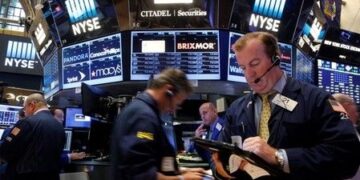Court blocks the bulk of Trump’s tariffs (read from the bottom up for the chronology)
Nvidia earnings (read from the bottom up for the chronology)
Other (ditto):
The session got off to a fast start with equity headlines leading the charge. Nvidia’s Q1 earnings release made a messy entrance — the company initially published an incorrect EPS figure of 81c, well below the 93c expected. That was quickly corrected to 96c, turning the narrative into a modest beat. It wasn’t one of Nvidia’s typical blowout quarters, but good enough for shares to rise and lift the broader market alongside them.
But the real action came later.
A U.S. Federal Court — the Court of International Trade — ruled that President Donald Trump exceeded his authority in imposing tariffs on all imported goods. The so-called “Liberation Day” tariffs, enacted under the International Emergency Economic Powers Act (IEEPA) of 1977, were declared illegal and blocked via injunction. A three-judge panel found that Congress did not delegate the president open-ended authority to set tariffs. Importantly, Trump’s sector-specific tariffs were not addressed and remain in place for now.
Trump has already filed an appeal and has several potential paths forward:
-
Appeal to the U.S. Court of Appeals for the Federal Circuit
-
Escalate to the Supreme Court
-
Seek Congressional approval
-
Attempt to reframe the tariffs under alternative legislative authority
The road ahead is likely to be long, complex, and politically messy. Ongoing trade negotiations may continue, but this ruling weakens Trump’s negotiating leverage. The uncertainty is expected to weigh further on business investment. The projected tariff revenue — previously touted to bring in between $3.3 and $5.2 trillion over a decade — now looks increasingly speculative. That leaves a gaping hole in Trump’s deficit-financed “Big, Beautiful Bill” of tax cuts.
Goldman Sachs offered a different take, suggesting Trump could work around the ruling. Analysts noted he might reimpose a 10–15% tariff using Section 122 authority, buying time to launch Section 301 investigations targeting major trading partners. I’m no tariff lawyer, but one assumes Goldman’s view is on solid ground.
Markets reacted decisively. The U.S. dollar surged, with safe haven currencies like the yen and franc falling sharply. U.S. equity futures built on earlier gains.
In the region, the main local data point was Australian Q1 private capital expenditure. Business investment fell 0.1% q/q, against expectations of a 0.5% gain. Mining capex rose, but this was offset by weakness elsewhere — particularly a drop in equipment spending, which could drag on near-term GDP. Forward-looking plans were more encouraging, with firms projecting A$155.9 billion in capex for the 2025/26 financial year, broadly in line with forecasts.
The yen, and CHF, weakened on the court ruling news:
ForexLive.com
is evolving into
investingLive.com, a new destination for intelligent market updates and smarter
decision-making for investors and traders alike.












